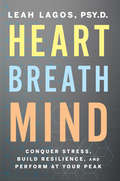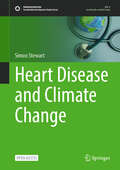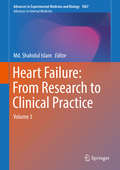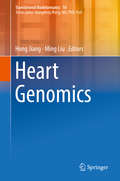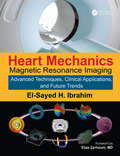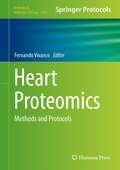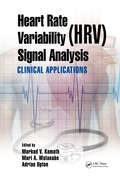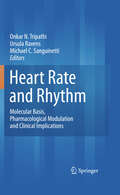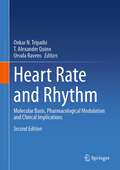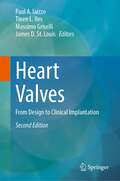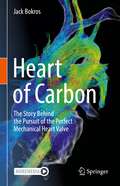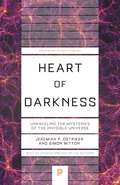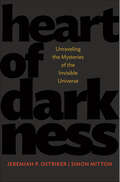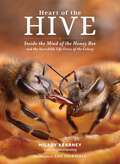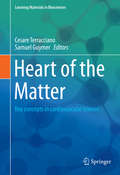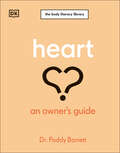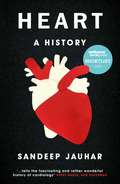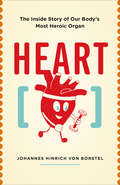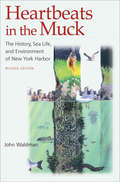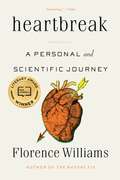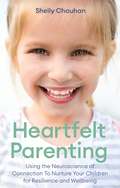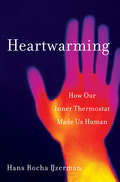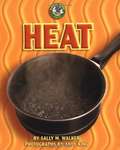- Table View
- List View
Heart Breath Mind: Train Your Heart to Conquer Stress and Achieve Success
by Dr. Leah LagosStress is not in your head, it&’s in your body—this is the key to peak performance that Leah Lagos, PsyD, BCB, an internationally known expert in biofeedback and sport and performance psychology, wants us to know. In this book, she shares with readers for the first time the same program that she uses with top athletes, CEOs, business leaders—anyone who wants and needs to perform at their best. What makes her scientifically proven 10-week program unlike any other is that she recognizes the link between heart rhythms and stress to create specific, clinically tested exercises and breathing techniques that allow you to control your body&’s physical response to stress. She pairs this training with cognitive-behavioral exercises to offer a two-tiered process for strengthening health and performance, enabling readers to respond more flexibly to stressful situations, let go of negative thoughts and emotions, and ultimately be more focused and confident under pressure.
Heart Disease and Climate Change (Sustainable Development Goals Series)
by Simon StewartThis Open Access book describes how the aging populations of high-income countries and younger, more vulnerable populations living in low-to-middle income countries are increasingly affected by cardiac events (including hospitalisation and premature mortality) that do not occur randomly. Instead, they rise and fall in response to climatic conditions. This relationship represents a complex bio-behavioral interaction between individuals at risk of experiencing an acute cardiovascular event and their environment. Unfortunately, expert guidelines and epidemiological reports ignore this fundamental fact – cardiac events in nearly every country fluctuate with predictable climatic transitions (seasons) and random external provocations (including noise and air pollution plus unseasonal cold snaps and heat waves). Climate change, in the form of more unpredictable weather (including more sustained heat waves) will only exacerbate the problem, especially among the world’s poorest people. Heart Disease and Climate Change articulates why this phenomenon occurs, how climate change is likely to exacerbate the problem (thereby harming economies/stifling Development Goals) and what we need to do to mitigate the impact of climate change on heart health. It identifies key areas for future research/reporting of cardiac events and hence is an essential reference for all interested in the management of patients in cardiovascular medicine, from cardiologists, internists and primary care physicians to healthcare administrators, climate researchers and politicians.
Heart Failure: Volume 3 (Advances in Experimental Medicine and Biology #1067)
by Md. Shahidul Islam“Heart Failure: From Research to Clinical Practice” contains chapters that describe the current views on the biological mechanisms, clinical assessment, diagnosis and evidence-based treatments of the condition. Topics in this volume range from basic research at cell and molecular level to patient care in everyday clinical practice and provide essential background information and analyses of recent advances for a deeper understanding of the issues involved. With contributions from international experts in their specified fields and are suitable for both beginners and more advanced readers. This volume includes not only the essential information for clinical practice but also the latest information from the contemporary guidelines and the recommendations from leading societies. It also covers ongoing research and puts forward new hypotheses that can be tested in future research. This comprehensive volume will provide a valuable resource for both research students and expert clinicians.
Heart Genomics (Translational Bioinformatics #16)
by Hong Jiang Ming LiuThis book elucidates how advances in genomics research are being applied in connection with heart diseases. It describes the development of genome-scale technologies and their applications to all areas of cardiac investigations, such as genomics, functional genomics, epigenomics, etc., and how they relate to a series of important breakthroughs in various heart diseases. Applying unbiased genomics, combined with a disease-focused and hypothesis-driven approach, represents a promising way to advance our understanding of cardiac diseases. The book offers an important reference work on introducing genomics in heart disease for all scientists and graduate students whose work involves genomics and cardiology, as well as for clinical physicians.
Heart Mechanics: Magnetic Resonance Imaging—Advanced Techniques, Clinical Applications, and Future Trends
by El-Sayed H. IbrahimBased on research and clinical trials, this book details the latest research in magnetic resonance imaging (MRI) tagging technology related to heart mechanics. It covers clinical applications and examines future trends, providing a guide for future uses of MRI technology for studying heart mechanics.
Heart Mechanics: Magnetic Resonance Imaging—Mathematical Modeling, Pulse Sequences, and Image Analysis
by El-Sayed H. IbrahimMRI techniques have been recently introduced for non-invasive qualification of regional myocardial mechanics, which is not achievable with other imaging modalities. Covering more than twenty-three years of developments in MRI techniques for accessing heart mechanics, this book provides a plethora of techniques and concepts that assist readers choose the best technique for their purpose. It reviews research studies and clinical trials that implemented MRI techniques for studying heart mechanics.
Heart Proteomics
by Fernando VivancoThe use of proteomics to study complex diseases such as cardiovascular disease, the leading cause of death in developed countries, has grown exponentially in recent years. Proteomics is a rapidly expanding investigation platform in cardiovascular medicine and is becoming integrated and incorporated into cardiovascular research. The proteomics field continues to develop with major improvements in mass spectrometry instrumentation, methodology and data analysis. Heart Proteomics: Methods and Protocols complies a selection of techniques and methods that target the numerous processes implicated in the pathophysiology of heart. Chapters cover protocols and updated methods in the heart proteomic area with a particular focus on MS-based methods of protein and peptide quantification and the analysis of posttranslational modifications as well as descriptions of system biology approaches, which provide a better understanding of normal and pathological processes. Written in the successful Methods in Molecular BiologyTM series format, chapters include introductions to their respective topics, lists of the necessary materials and reagents, step-by-step, readily reproducible protocols, and notes on troubleshooting and avoiding known pitfalls. Authoritative and easily accessible, Heart Proteomics: Methods and Protocols is a representative selection of methods that will prove to be a useful resource for experienced proteomics practitioners and newcomers alike.
Heart Rate Variability (HRV) Signal Analysis: Clinical Applications
by Markad V. Kamath Mari A. Watanabe Adrian R.M. UptonOpen a Window into the Autonomic Nervous SystemQuantifying the amount of autonomic nervous system activity in an individual patient can be extremely important, because it provides a gauge of disease severity in a large number of diseases. Heart rate variability (HRV) calculated from both short-term and longer-term electrocardiograms is an ideal win
Heart Rate and Rhythm
by Michael C. Sanguinetti Onkar N. Tripathi Ursula RavensPathological heart rhythms are a major health issue. In this book experts from various fields provide an important context for understanding the complicated molecular and cellular mechanisms that underlie normal and pathophysiological cardiac rhythms. Individual chapters cover a full range of topics, including the ionic basis of pacemaking, the role of specific channels and transporters in sinoatrial node pacemaking, altered intracellular Ca2+ handling in response to disease, computer modeling of the action potentials of pacemaker and working cardiomyocytes, genetic and molecular basis of inherited arrhythmias and a review of established and novel antiarrhythmic agents. Due to the key importance of the specialized pacemaker cells and tissue (sinoatrial and atrioventricular nodes) in maintaining heart rate and rhythm, special emphasis is placed on the peculiar electrophysiology of these cells.
Heart Rate and Rhythm: Molecular Basis, Pharmacological Modulation and Clinical Implications
by Onkar N. Tripathi Ursula Ravens T. Alexander QuinnThis completely updated and expanded 2nd Edition provides all the information needed in order to understand the complex molecular, cellular and genetic mechanisms that underlie normal and abnormal cardiac rhythms. Its goal is to help physiologists and clinicians alike develop better preventive and treatment strategies. The respective chapters cover a broad range of topics, including the role of specific ion channels and transporters, gap junctions, intracellular Ca2+ handling in pacemaker activity, impulse conduction, and the activity of atrial and ventricular myocardium. Special emphasis is placed on the unique electrophysiology of specialized pacemaking cells and conducting fibers. In turn, several types of inherited and acquired ventricular arrhythmias are presented in detail. Clinicians will especially appreciate the updated information on even common disorders like atrial fibrillation and their impacts on human physiology. In closing, the book goes “one step further” and considers future prospects, e.g. novel antiarrhythmic agents and new concepts like optogenetics, in the context of heart rate regulation. Accordingly, it offers readers a solid reference guide to everything they need to know about human heart rate and rhythm.
Heart Valves: From Design to Clinical Implantation
by Paul A. Iaizzo James D. St. Louis Tinen L. Iles Massimo GriselliThis state-of-the-art handbook is dedicated to cardiac valve anatomy, models for testing and research methods, clinical trials; and clinical needs and applications. In this new edition, chapters are updated with the latest research in addition to new chapters on complex repair of CHD requiring conduits, new trends for valve replacement like the Ozaki procedure, as well as complex procedures in TAV, SAV, HARPOON, and BASILICA, with case studies for each type of procedure. This volume serves as a helpful reference for patients, educators, students, device designers and developers, clinical study specialists, clinicians, and other associated healthcare providers.
Heart of Carbon: The Story Behind the Pursuit of the Perfect Mechanical Heart Valve
by Jack BokrosThis book offers a historical account of the development of the On-X carbon mechanical heart valve, discussing the steps involved in developing the materials, and describes how the design of the valve has evolved over the years. It explores both the scientific and corporate problems researchers have encountered over the years in the journey of making a mechanical heart valve. The chapters provide a detailed description of the design of the mechanical leaflet-based prosthetic valve, with a particular focus on blood flow characteristics. This book includes an overview of the state-of-the-art in the chemistry and physics of carbon, and compiles the advances in carbon-based technology and its applications in cardiac and thoracic surgery.This is an ideal book for bioengineers working on the chemistry and physics of carbon, and other professionals involved with cardiac and thoracic surgery.
Heart of Darkness: Unraveling the Mysteries of the Invisible Universe (Princeton Science Library #148)
by Jeremiah P. Ostriker Simon MittonHumanity's ongoing quest to unlock the secrets of dark matter and dark energyHeart of Darkness describes the incredible saga of humankind's quest to unravel the deepest secrets of the universe. Over the past forty years, scientists have learned that two little-understood components—dark matter and dark energy—comprise most of the known cosmos, explain the growth of all cosmic structure, and hold the key to the universe's fate. The story of how evidence for the so-called "Lambda-Cold Dark Matter" model of cosmology has been gathered by generations of scientists throughout the world is told here by one of the pioneers of the field, Jeremiah Ostriker, and his coauthor Simon Mitton.From humankind's early attempts to comprehend Earth's place in the solar system, to astronomers' exploration of the Milky Way galaxy and the realm of the nebulae beyond, to the detection of the primordial fluctuations of energy from which all subsequent structure developed, this book explains the physics and the history of how the current model of our universe arose and has passed every test hurled at it by the skeptics. Throughout this rich story, an essential theme is emphasized: how three aspects of rational inquiry—the application of direct measurement and observation, the introduction of mathematical modeling, and the requirement that hypotheses should be testable and verifiable—guide scientific progress and underpin our modern cosmological paradigm.This monumental puzzle is far from complete, however, as scientists confront the mysteries of the ultimate causes of cosmic structure formation and the real nature and origin of dark matter and dark energy.
Heart of Darkness: Unraveling the Mysteries of the Invisible Universe (Science Essentials #18)
by Jeremiah P. Ostriker Simon MittonHumanity's ongoing quest to unlock the secrets of dark matter and dark energyHeart of Darkness describes the incredible saga of humankind's quest to unravel the deepest secrets of the universe. Over the past forty years, scientists have learned that two little-understood components—dark matter and dark energy—comprise most of the known cosmos, explain the growth of all cosmic structure, and hold the key to the universe's fate. The story of how evidence for the so-called "Lambda-Cold Dark Matter" model of cosmology has been gathered by generations of scientists throughout the world is told here by one of the pioneers of the field, Jeremiah Ostriker, and his coauthor Simon Mitton.From humankind's early attempts to comprehend Earth's place in the solar system, to astronomers' exploration of the Milky Way galaxy and the realm of the nebulae beyond, to the detection of the primordial fluctuations of energy from which all subsequent structure developed, this book explains the physics and the history of how the current model of our universe arose and has passed every test hurled at it by the skeptics. Throughout this rich story, an essential theme is emphasized: how three aspects of rational inquiry—the application of direct measurement and observation, the introduction of mathematical modeling, and the requirement that hypotheses should be testable and verifiable—guide scientific progress and underpin our modern cosmological paradigm.This monumental puzzle is far from complete, however, as scientists confront the mysteries of the ultimate causes of cosmic structure formation and the real nature and origin of dark matter and dark energy.
Heart of the Hive: Inside the Mind of the Honey Bee and the Incredible Life Force of the Colony
by Hilary KearneyExpert beekeeper and swarm-catcher Hilary Kearney offers a unique window into the social lives and biology of these remarkable creatures, accompanied by the photos of world-renowned bee photographer Eric Tourneret. Readers will be awestruck by the hive as superorganism and how the individual bee lives and behaves within it, perfectly suited to each specific job it performs. From their intricate dances and information-rich pheromones to how they sense and respond to their environment, learn, and remember, this immersive journey into the world of bees offers an entirely new perspective on the wisdom of nature and our relationship to it.
Heart of the Matter: Key concepts in cardiovascular science (Learning Materials in Biosciences)
by Cesare Terracciano Samuel GuymerThis textbook introduces readers to the scientific basics of cardiovascular medicine and biology. It covers not only developmental but also cellular and molecular aspects of normally functioning vasculature and the heart; importantly, it also addresses the mechanisms leading to and involved in specific cardiovascular diseases. Though the main emphasis is on novel therapies and potential therapeutic targets, specific controversial topics like cardiac remodeling and regenerative capacities are also addressed. All chapters were written by lecturers from the Imperial College London, in collaboration with their students from the College’s BSc Programme in Medical Sciences with Cardiovascular Science. Bridging the gap between clinics and basic biology, the book offers a valuable guide for medical students, and for Master and PhD students in Cardiovascular Biomedicine.
Heart on Pluto
by Karl JonesLove is everywhere, even in the fartherst reaches of the Solar System. On NASA's first-ever mission to Pluto, the New Horizons satellite discovers that even when you're far from home, you are loved.New Horizons was the first NASA satellite to visit and take close-up images of Pluto. And though the journey was long and challenging, New Horizons discovered a message of love in the heart-shaped nitrogren ice lake on Pluto's surface.
Heart: An Owner's Guide (The Body Literacy Library)
by Paddy BarrettBecome body literate with Heart: An Owner's Guide, the next book in The Body Literacy Library, a helpful series that will break down heart health for a new generation of readers.Heart: An Owner's Guide is an informative, practical, and engaging introduction to all aspects of heart health to live well and longer. Find the key to a long, healthy life and your cardiac risk.Author Dr Paddy Barrett is an engaging and media-friendly Consultant Cardiologist specializing in preventative health care. He translates medical jargon into simple, straightforward prose, answering frequently asked patient queries, such as Should I take aspirin? Are heart attacks hereditary? Is red wine healthy? And much more.In this book, you can find:-Easy-to-follow science and lifestyle advice with simple Q&As. -Illustrations with data-driven images that show how certain lifestyle choices impact your health.-Best tips to help you know how to best care for your body and heart.-Chapters that outline the vital organ and how it works, risks for heart problems, and what to do to improve heart health. From what you should eat (or not) and exercising smarter to why stress is as dangerous as smoking, this hard-working book applies science to the everyday, with simple illustrations, checklists, FAQs, and myth busters, all supported by the latest medical research. Heart: An Owner's Guide won't just help you understand your body better.
Heart: Shortlisted for the Wellcome Book Prize 2019
by Sandeep Jauhar&‘Jauhar weaves his own personal and family story into his history of the heart…very effectively… This gives a certain dramatic tension to the book, as it tells the fascinating and rather wonderful history of cardiology.&’ –Henry Marsh, New StatesmanA Mail on Sunday Book of the Year The heart lies at the centre of life. For cardiologist Sandeep Jauhar it is an obsession. In this fascinating history he interweaves gripping scenes from the operating theatre with the moving tale of his family&’s history of heart problems – from the death of his grandfather to the ominous signs of how he himself might die. Jauhar looks at the pioneers who risked patients&’ lives and their own careers, and confronts the limits of medical technology, arguing that how we live is more important than any device or drug we may invent. Heart is the all-encompassing story of the engine of life.
Heart: The Inside Story of Our Body's Most Heroic Organ
by Johannes Hinrich von Borstel&“Describes the physiology behind the normal function of the heart with gusto and humor . . . well informed and accessible . . . a necessary book.&” —Readings In this lively and informative exploration of all aspects of the heart, Johannes Hinrich von Borstel offers a perfect mix of medical fact and amusing anecdote. A doctor, prospective cardiologist, and former paramedic—as well as a successful science-slammer—von Borstel relates his own experiences to provide a personal insight into the human side of heart medicine, while clearly explaining the science behind cardiac disease and healthcare for the heart. His many tips on how to give your ticker the best chance of enduring for as long as possible include one that will certainly be close to many people&’s hearts: have more sex! Oh, and eat more vegetables. &“Whether your heart is healthy or not, everyone should read this book, because the author has truly put his heart and soul into it.&” —Shelf Life &“While von Borstel cautions against these excesses, his youthful enthusiasm and gusto for his subject makes for a lively read.&” —The Sydney Morning Herald &“An eminently readable book which strikes a very good balance between information and anecdote . . . should be of interest to anyone who wants to know what goes on &‘under the hood&’ as it were, regardless of your level of anatomical understanding . . . this is a marvelous book.&” —Yinspire
Heartbeats in the Muck: The History, Sea Life, and Environment of New York Harbor, Revised Edition
by John WaldmanHeartbeats in the Muck traces the incredible arc of New York Harbor’s environmental history. Once a pristine estuary bristling with oysters and striped bass and visited by sharks, porpoises, and seals, the harbor has been marked by centuries of rampant industrialization and degradation of its natural environment. Garbage dumping, oil spills, sewage sludge, pesticides, heavy metals, poisonous PCBs, landfills, and dredging greatly diminished life in the harbor, in some places to nil. Now, forty years after the Clean Water Act began to resurrect New York Harbor, John Waldman delivers a new edition of his New York Society Library Award–winning book. Heartbeats in the Muck is a lively, accessible narrative of the animals, water quality, and habitats of the harbor. It includes captivating personal accounts of the author’s explorations of its farthest and most noteworthy reaches, treating readers to an intimate environmental tour of a shad camp near the George Washington Bridge, the Arthur Kill (home of the resurgent heron colonies), the Hackensack Meadowlands, the darkness under a giant Manhattan pier, and the famously polluted Gowanus Canal. A new epilogue details some of the remarkable changes that have come upon New York Harbor in recent years. Waldman’s prognosis is a good one: Ultimately, environmental awareness and action has allowed the harbor to begin cleaning itself. Although it will never regain its native biological glory, the return of oysters, herons, and a host of other creatures is an indication of New York Harbor’s rebirth. This excellent, engaging introduction to the ecological issues surrounding New York Harbor will appeal to students and general readers alike. Heartbeats in the Muck is a must-read for anyone who likes probing the wilds, whether country or city, and natural history books such as Beautiful Swimmers and Mannahatta.
Heartbreak: A Personal and Scientific Journey
by Florence WilliamsWinner of the 2023 PEN/E.O. Wilson Literary Science Writing Award A Five Books "Best Literary Science Writing" Book of 2023 • A Smithsonian Best Science Book of 2022 • A Prospect Magazine Top Memoir of 2022 • A KCRW Life Examined Best Book of 2022 "Keen observer [and] deft writer" (David Quammen) Florence Williams explores the fascinating, cutting-edge science of heartbreak while seeking creative ways to mend her own. When her twenty-five-year marriage suddenly falls apart, journalist Florence Williams expects the loss to hurt. But when she starts feeling physically sick, losing weight and sleep, she sets out in pursuit of rational explanation. She travels to the frontiers of the science of "social pain" to learn why heartbreak hurts so much—and why so much of the conventional wisdom about it is wrong. Soon Williams finds herself on a surprising path that leads her from neurogenomic research laboratories to trying MDMA in a Portland therapist’s living room, from divorce workshops to the mountains and rivers that restore her. She tests her blood for genetic markers of grief, undergoes electrical shocks while looking at pictures of her ex, and discovers that our immune cells listen to loneliness. Searching for insight as well as personal strategies to game her way back to health, she seeks out new relationships and ventures into the wilderness in search of an extraordinary antidote: awe. With warmth, daring, wit, and candor, Williams offers a gripping account of grief and healing. Heartbreak is a remarkable merging of science and self-discovery that will change the way we think about loneliness, health, and what it means to fall in and out of love.
Heartfelt Parenting: Using the Neuroscience of Connection To Nurture Your Children for Resilience and Wellbeing
by Shelly ChauhanDrawing on current powerful neuroscience, this book equips you with a deep insight into how your interconnected brain, mind and body shapes your capacity for heartfelt connection, emotional regulation and compassion, and the compelling influence this has on your child's developing mind.We know, based on established brain science, that children develop well in the care of parents who can regulate and express their own emotions effectively, who are present and attentive rather than in 'autopilot' mode, and who show warmth, empathy and compassion along with the requisite level of authority towards them. But in this day and age of relentless mental overload, busy schedules and constant stimulation, many parents know how difficult it can be to exude the sense of openness, warmth and connection that children need to develop well. The last thing parents need is yet more prescriptive advice about what you should and shouldn't think, do or say as a parent, so this this book helps you understand, in a tangible way, how to feel relaxed, open and compassionate when you are around your children. This is a vital ingredient in parenting, because this feeling state, involving your brain, nervous system, heart, facial expressions and voice, deeply calms your children, enables them to listen to you and respect your rules, and nourishes their brains for life-long resilience, empathy, self-acceptance and authenticity. Shelly Chauhan's approach removes some of the stress and complexity that parenting seems to involve these days and turns it into the intuitive, natural and enjoyable process it is able to be.
Heartwarming: How Our Inner Thermostat Made Us Human
by Hans Rocha IJzermanAn illuminating investigation of core body temperature regulation and its powerful effect on human civilization. A hot cup of tea, coffee, or cocoa is calming and comforting—but how can holding a warm mug affect our emotions? In Heartwarming, social psychologist Hans Rocha IJzerman explores temperature through the long lens of evolution. Besides breathing, regulating body temperature is one of the most fundamental tasks for any animal. Like huddling penguins, we humans have long relied on one another to maintain our temperatures; over millennia, this instinct for thermoregulation has shaped our lives and culture. Temperature contributed to our evolution—our upright walking, our loss of fur, and our big brains—and now continues to affect our lives in unexpected ways, and the link from a warm mug to our emotions is anything but straightforward. Studies have shown, for example, that a chilly deliberation room can predispose a jury to convict and that a cold day can make us more likely to buy a house. Our mind-body connection works the other way, too: thinking about friendly or caring people can make us feel warmer. Understanding how we subconsciously strive to keep our temperature in an optimal range can help us in our relationships, jobs, and even in the world of social media. As IJzerman illuminates how temperature affects human sociality, he examines fascinating new questions: How will climate change impact society? Why are some people chronically cold, and others overheated? Can thermoregulation keep relationships closer, even across a distance? The answers offer new insights for all of us who want to better understand our bodies, our minds, and each other. Heartwarming takes readers on an engaging journey through the world, seen from the perspectives of coldness and warmth.
Heat (Early Bird Energy)
by Sally M. WalkerHeat is important for all animals and plants. Without any heat, living things die. The same thing happens if living things get too much heat. But the right amount of heat, animals and plants live and grow. Heat from the sun helps keep living things healthy.
